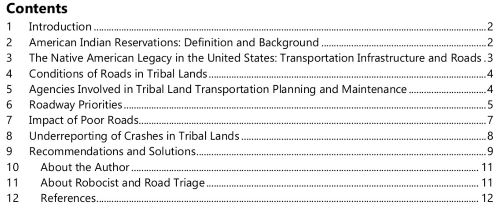![]() Return to all articles
Return to all articles

- By: Jeffrey Barghout
- /
- 4 minute read
- /
- March 2023
Paving the Way for Tribal Lands:
The Infrastructure Crisis Impact on Native Communities
Download and read the full article (10 minute read)
Safe roads and bridges are essential components of a well-functioning infrastructure system, as they enable people to access various essential services and opportunities, such as healthcare facilities, shopping centers, recreational areas, educational institutions, and workplaces. A lack of well-maintained and properly paved roads can significantly restrict the mobility and overall quality of life for individuals, making it difficult for them to travel and commute efficiently. In particular, the people living in tribal lands have long been facing the challenge of inadequate and deteriorating road networks. This article aims to explore the road networks in tribal lands, delving into their current state, the methods employed for maintenance and repair, as well as discussing potential solutions and recommendations for improvement.
The transportation infrastructure in tribal lands has long been a pressing issue that requires urgent attention. According to a report by the Centers for Disease Control and Prevention (CDC), motor vehicle traffic crashes are a leading cause of death for most American Indian and Alaska Native people. This alarming statistic is primarily due to the dangerous roads that connect tribal lands, which are heavily relied upon for transportation. The lack of proper maintenance and repair of these roads has led to hazardous conditions for buses, cars, and trucks alike.
The Tribal Transportation Program (TTP) plays a crucial role in addressing the transportation needs of tribes across the United States. This program provides essential funding for planning, designing, construction, and maintenance activities for all public roads within tribal lands. In recent years, the federal government has allocated significant funds to support the construction and repair of tribal roads. More recently, the Infrastructure Investment and Jobs Act has allocated an unprecedented $1.2 trillion in funding to improve various aspects of the nation's infrastructure, including the Tribal Transportation Program.
To address the numerous causes of fatal crashes in tribal areas, the Tribal Transportation Safety Management System (SMS) Steering Committee has identified seven major concerns in tribal areas based on the documentation and data collected. These seven topics guide the planning, design, construction, and evaluation of roads in these regions, focusing on decision-making processes, crash data availability and limitations, occupant protection, roadway departure, impaired driving, pedestrian safety, and availability of public safety services.
Native tribes across the United States are grappling with the negative consequences of poor road conditions on their lands. Cracked, bumpy, and unpaved roads, coupled with poor road markings and a lack of critical safety infrastructure such as traffic lights and stop signs, continue to hamper economic development and the overall well-being of these communities. The substandard roads on tribal lands also limit tribal members' access to essential services and amenities, further hindering the economic growth and development of Native tribes.
The underreporting of crashes in tribal lands is a significant issue that hinders accurate data collection and impedes efforts to improve road safety in these regions. Factors contributing to underreporting include insufficient expertise in traffic collision investigation and reporting, desire to maintain data confidentiality, inadequate infrastructure, greater distance to trauma centers, and limited resources. Addressing these factors is crucial for developing efficient and effective transportation plans and improving road safety in tribal lands.
The urgent need to improve road infrastructure in tribal lands cannot be overstated. To address the challenges faced in maintaining and repairing roads on tribal lands, it is crucial for relevant agencies and stakeholders to adopt advanced technologies for accurate and efficient data collection. By doing so, they can effectively address the priority topics outlined in the GAO report and ultimately improve the quality of life for those living on tribal lands. One such solution is Road Triage, an AI-powered assessment tool that offers numerous benefits for efficient and effective data collection and analysis.
By leveraging AI and Machine Learning technologies, Road Triage provides current and actionable intelligence on road conditions, enabling decision-makers to make informed decisions on infrastructure maintenance and resource allocation. Some of the key advantages of using Road Triage and similar AI assessment tools include lower costs, simplified data collection processes, accurate and comprehensive data support.
Investing in AI-powered solutions for road infrastructure is not only a cost-effective approach but also a necessary step towards a better future for tribal communities. Let us work together to ensure that the roads in tribal lands are safe, well-maintained, and contribute to the overall well-being and prosperity of American Indian and Alaska Native people.
About the author:
Jeffrey Barghout is an accomplished Technology Developer and Business Strategist with over 25 years of experience in technology evaluation and strategic planning. As the CEO of Robocist, he is dedicated to developing and accelerating the adoption of emerging transportation technologies, including connected, autonomous, and electric vehicles, as well as utilizing artificial intelligence (AI) to quantify the driven environment.
Jeff's extensive background includes serving as an engineer and strategic planner at Chrysler, assessing technologies for NASA, and holding the position of Vice President of Transportation Initiatives at a leading research and consulting firm. He has been a successful serial entrepreneur, launching and growing businesses in various industries.
He participates in numerous advisory groups and serves on the Board of Directors for organizations like E4 Carolinas. With a proven track record of delivering results in both technology and business strategy, Jeff has navigated the complex intersection of technology, market forces, regulation, and stakeholder opinions, perceptions, and needs.

